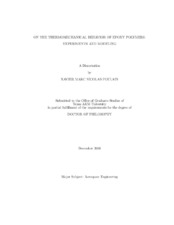| dc.contributor.advisor | Benzerga, Amine A. | |
| dc.creator | Poulain, Xavier Marc Nicolas | |
| dc.date.accessioned | 2012-02-14T22:19:09Z | |
| dc.date.accessioned | 2012-02-16T16:14:13Z | |
| dc.date.available | 2012-02-14T22:19:09Z | |
| dc.date.available | 2012-02-16T16:14:13Z | |
| dc.date.created | 2010-12 | |
| dc.date.issued | 2012-02-14 | |
| dc.date.submitted | December 2010 | |
| dc.identifier.uri | https://hdl.handle.net/1969.1/ETD-TAMU-2010-12-9022 | |
| dc.description.abstract | Amorphous polymers under their glass transition temperature (Tg) exhibit large
inelastic deformations. Their mechanical behavior is highly dependent upon temperature,
strain rate, pressure and loading mode (tension, compression, shear). They
also exhibit small strain isotropic hardening, softening and large strain anisotropic
rehardening. In addition, while in their glassy state, polymers are far from thermodynamic
equilibrium so that their properties may change over time (physical aging).
This complex behavior is reflected in the response of composites and affects the onset
and propagation of damage therein. Therefore, in order to design polymer composite
structures, it is fundamental to develop relevant tools and methodologies which aim
at understanding, capturing and predicting the full thermomechanical response of
glassy polymers.
In this study, the thermomechanical behavior of a thermosetting polymer epoxy
is characterized experimentally for temperatures below Tg. The intrinsic behavior of
the polymer is obtained using a new methodology based on digital image correlation
(DIC) in combination with video-monitored extensometry. In particular, inelastic flow
localization patterns are discussed based on the full-field strain measurements and
their connection to the stress-strain curves are highlighted. The Boyce-Parks-Argon polymer constitutive model, hereafter called the macromolecular model, has been
enhanced to describe the thermomechanical behavior of epoxies. The identification of
the material parameters involved in the model is described in a detailed procedure that
builds on a limited set of experiments. The model is shown to represent adequately the
thermomechanical behavior of the studied epoxy over a wide range of temperatures
and strain-rates. Using additional high strain-rate data obtained from collaborators
on Kolsky bars, the model capabilities are further discussed. Using finite-element
implementations of the constitutive model in both quasi-static and dynamic codes,
the processes of plastic flow localization are analyzed in tensile and compression
specimens. Such analysis can form the basis of an alternative method for identifying
the model parameters through inverse identification.
Finally, a preliminary set of experiments were also conducted to investigate the
effect of physical aging on the yield behavior and enhance the macromolecular model
with the capability of modeling aging effects. Our interpretation of the aging experiments
suggests that they are not conclusive and do not permit full determination of
model parameters. Specific recommendations are tentatively formulated for conducting
aging experiments in the future. | en |
| dc.format.mimetype | application/pdf | |
| dc.language.iso | en_US | |
| dc.subject | modeling | en |
| dc.subject | experimental characterization | en |
| dc.subject | polymer epoxies | en |
| dc.subject | digital image correlation | en |
| dc.subject | full-field measurements | en |
| dc.subject | video-based extensometry | en |
| dc.title | On the Thermomechanical Behavior of Epoxy Polymers: Experiments and Modeling | en |
| dc.type | Thesis | en |
| thesis.degree.department | Aerospace Engineering | en |
| thesis.degree.discipline | Aerospace Engineering | en |
| thesis.degree.grantor | Texas A&M University | en |
| thesis.degree.name | Doctor of Philosophy | en |
| thesis.degree.level | Doctoral | en |
| dc.contributor.committeeMember | Talreja, Ramesh | |
| dc.contributor.committeeMember | Kinra, Vikram | |
| dc.contributor.committeeMember | Strouboulis, Teofanis | |
| dc.contributor.committeeMember | Muliana, Anastasia | |
| dc.type.genre | thesis | en |
| dc.type.material | text | en |


